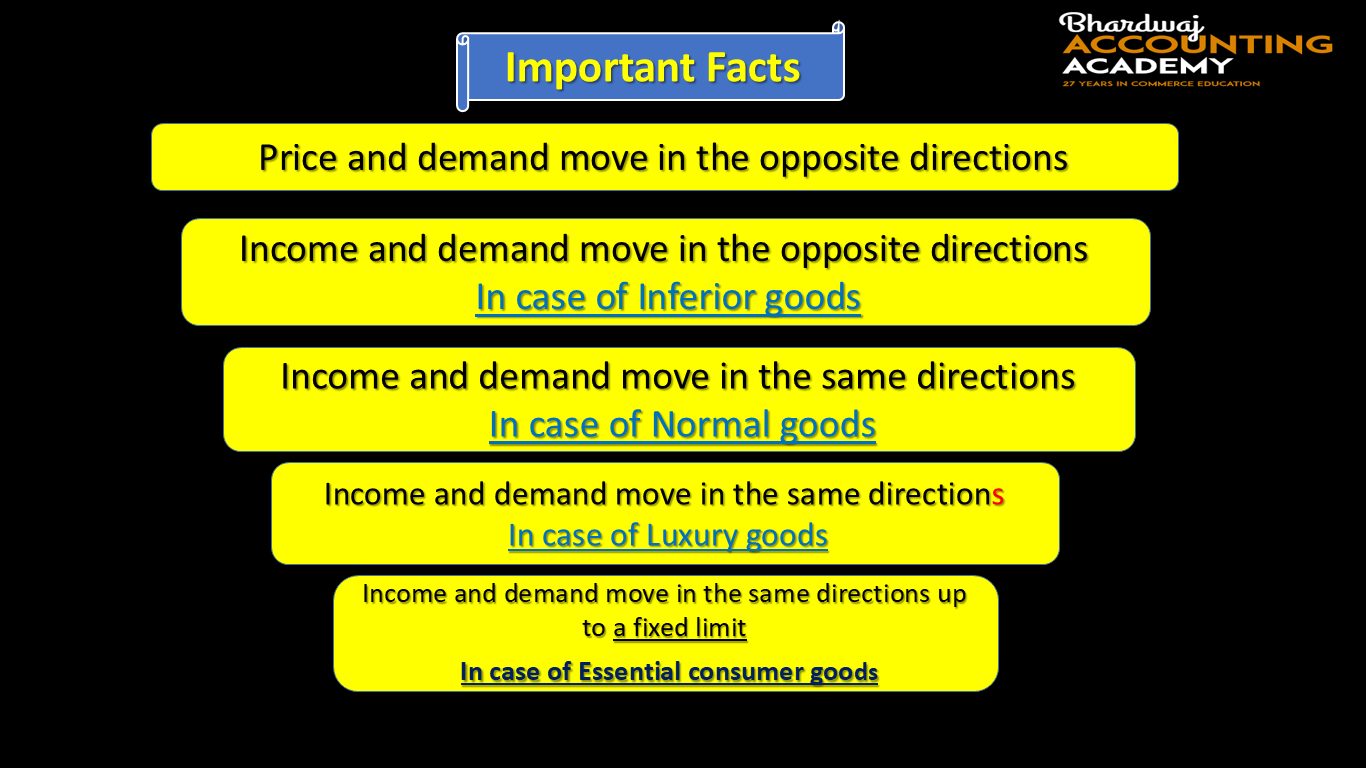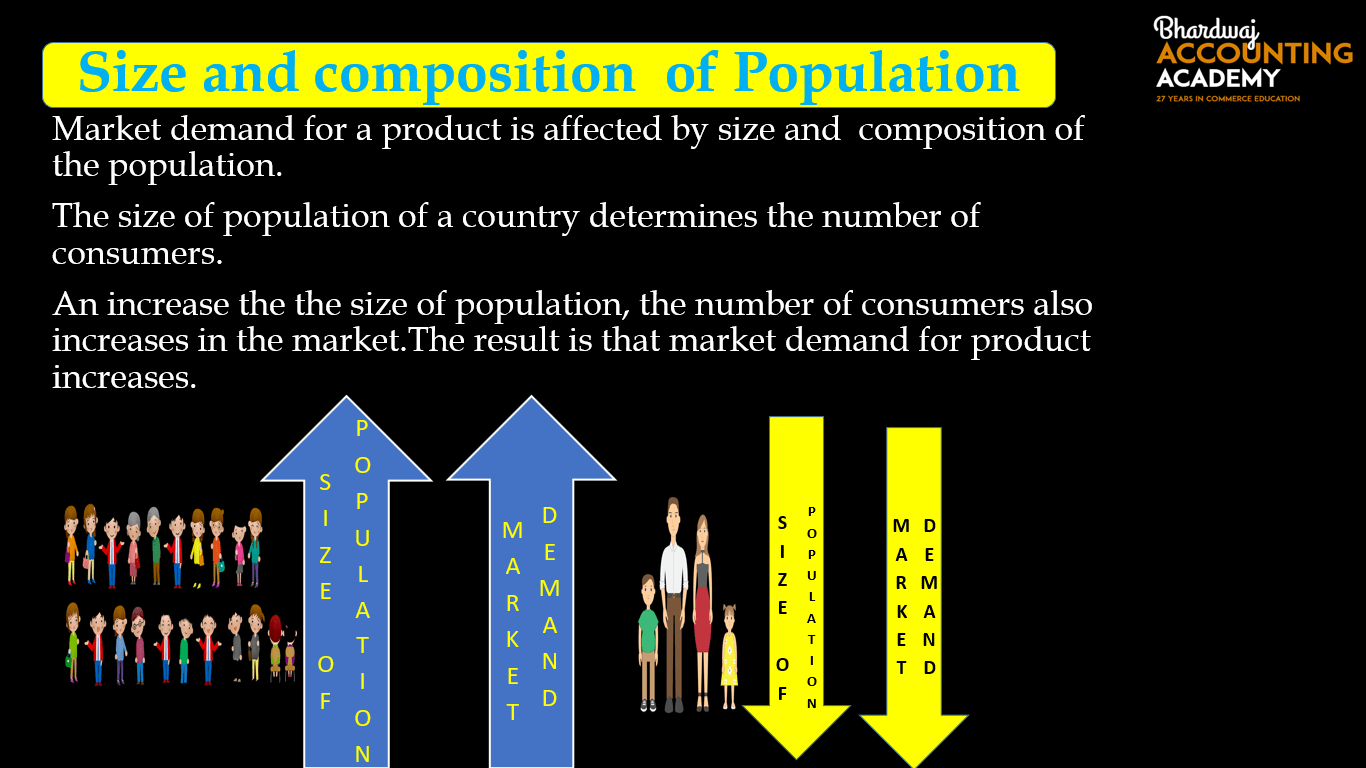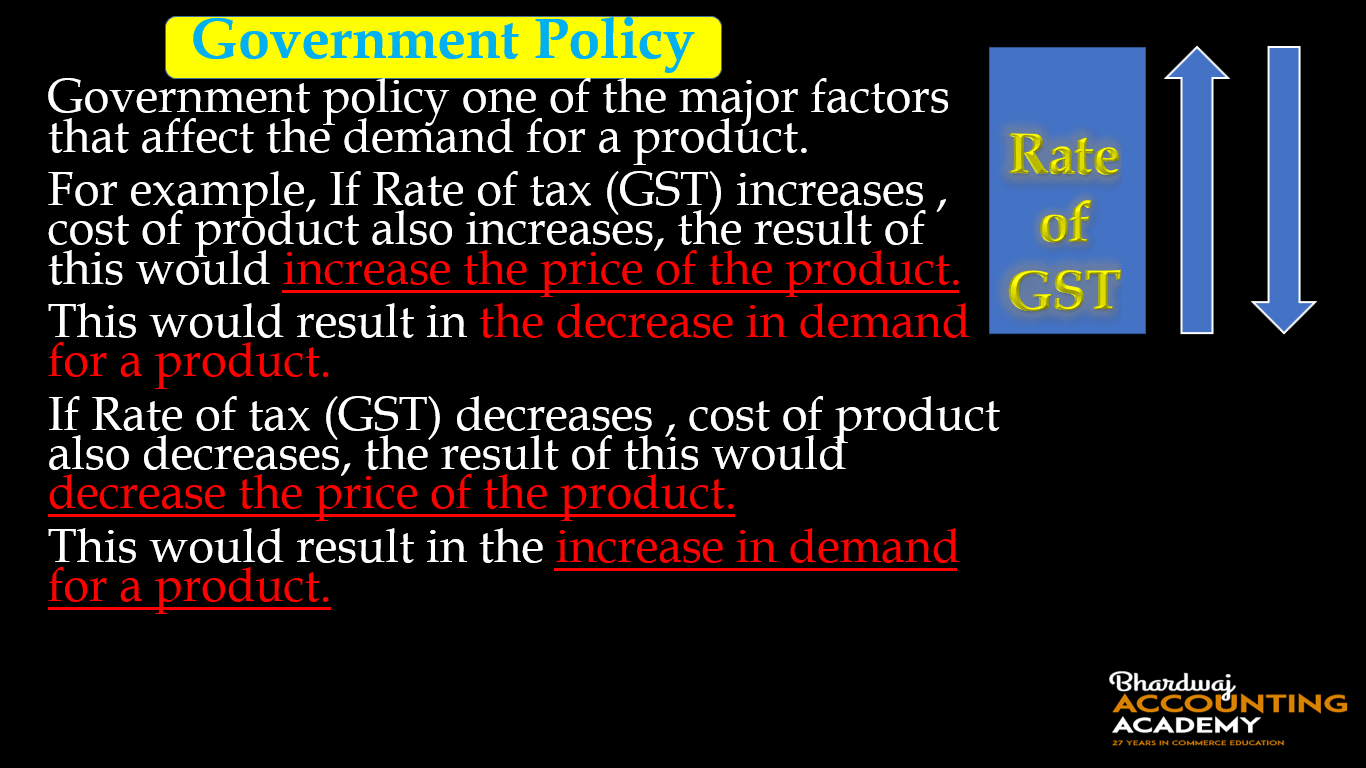Table of Contents
FACTORS AFFECTING DEMAND OR DETERMINANTS OF DEMAND
Factors affecting demand Or Determinants of demand –
The factors which affect the demand for a commodity are known as Determinants of demand or Factors affecting demand. The Important determinants of demand as follows:-
- Price of the commodity
- The income of the consumer
- Tastes and Preferences of Consumers
- Price of Related Goods
- Future Expectations of Consumers
- Effect of Advertisements
- Distribution of Income in the Society
- Size and composition of Population
- Government Policy
- Climatic Conditions
- Consumer credit facilities
- Demonstration Effect
Factors affecting demand Or Determinants of demand
1. Price of the commodity-
Own price of the commodity is the most important factor affecting demand for the given commodity.
There is an inverse relationship between the price of the commodity its quantity demanded.
When own price of a commodity falls, its demand rises and when own price rises, its demand falls.
The demand for a product decreases with increase in its price and demand for a product increases with decrease in its price while other factors are constant.
Thus we can say that there is an indirect (Inverse) relation between the price of a commodity and its quantity demanded.
2.Income of the consumer-
Income of the consumer (Y) is another important factor which affecting demand for the given commodity. The income of a consumer affects his/her purchasing power.
Generally ,there is a direct relationship between the income of the consumer and his demand for a product. Increase in the income of a consumer would automatically increase the demand for products by him/her, while other factors are at constant, and vice versa.
The income-demand relationship can be analyzed by grouping goods into four categories, namely,
a.Essential consumer goods,
b.Normal goods,
c.Inferior goods,
d.Luxury goods.
a.Essential consumer goods-
Essential consumer goods refer to goods that are consumed by all the people in society. For example, food grains, soaps, oil, cooking fuel, salt, matchbox.
The quantity demanded basic consumer goods increases with an increase in the income of a consumer, but up to a fixed limit, while other factors are constant.
b.Normal goods-
Normal Goods refer to goods whose demand increases with increase in the consumer’s income.
For example, goods such as clothing, vehicles, television, washing machine and food items, are demanded in relatively increasing quantity with increase in consumer’s income.
The demand for normal goods varies due to different rate of increase in consumers income.
Demand varies directly with income level. Income effect is positive
c.Inferior goods-
Inferior Goods refer to goods whose demand decreases with increase in the income of consumers and increase with the decrease in the income.
For example, a consumer would prefer to purchase wheat instead of millet(baajara) and cooking gas instead of kerosene, with increase in his/her income. In such a case, millet and kerosene are inferior goods for the consumer.
However, these two goods can be normal goods for people having lower level of income.
Therefore, we can say that goods are not always inferior or normal; it is the level of income of consumers and their perception about the need of goods.
Demand varies inversely with income level. Income effect is negative.
d.Luxury goods-
Luxury Goods refer to goods whose demand increases with increase in consumer’s income.
Luxury goods are used for the pleasure and esteem(reputation) of consumers.
For example, expensive jewellery items, luxury cars, antique paintings and wines, Rolex watches and air travelling.
Demand varies directly with income level.Income effect is positive
3. Tastes and Preferences of Consumers-
Tastes and Preferences of Consumers Play a major role in influencing the demand of a product.
*Demand for a particular commodity also changes with the changes in taste and preferences of the consumers.
The tastes and preferences of consumers are affected due to various factors such as……
Life styles, Social customs(rivaaj), Common habits, Change in fashion, Change in standard of living, Religious values and age. A change in any of these factors leads to change in the tastes and preferences of consumers.
Changes in taste and preferences of the consumers As a results changes the demand for a particular commodity.
Factors affecting demand Or Determinants of demand
4.Price of Related Goods-
Demand for the given commodity is also affected by change in prices of the related goods.
The effect depends on the nature of related goods. Related goods are of two types.
- Substitute Goods: Substitute goods are those goods which can be used in place of one another for satisfaction of particular want like…..
1.Tea and coffee. 2. Coke and Pepsi.- Pen and Pencil. 4. CD and DVD
- Groundnut oil and sunflower oil 6. Jowar and bajra
Since Tea is a substitute for Coffee, if the price of coffee increases, the consumers can shift to tea, and hence, the consumption of tea is likely to go up. On the other hand, if the price of coffee decreases, the consumption of tea is likely to go down.
- Complementary Goods: Complementary goods are those goods which are used together to satisfy a particular want or Goods which are consumed together are called complementary goods., like…..
- Tea and sugar. 2. Pen and Ink.
- Car and petrol. 4. Bread and butter.
- Brick and Cement 6. Pen and Refill
Since Car and petrol are used together, an increase in the price of petrol is likely to decrease the demand for car and a decrease in the price of petrol is likely to increase the demand for car.
In general, the demand for a goods moves in the opposite direction of the price of its complementary goods. The complementary goods are inversely related to each other.
5. Future Expectations of Consumers-
Consumer’s expectation about changes in prices in future and availability of goods will also affect the demand for a commodity.
If prices are expected to rise in future, consumers will make purchases in advance.
For example, if consumers expect that the prices of petrol would rise in the next week, then the demand of petrol would increase in the present.
On the other hand, consumers would delay the purchase of products whose prices are expected to be decreased in future
For example, if consumers expect that the prices of sugar would fall in the next week, then the demand of sugar would decrease in the present.
Moreover, the scarcity (Shortage) of specific products in future would also lead to an increase in their demand at present.
The possibility of future technological development also affects the current demand for products.
6. Effect of Advertisements–
Advertisement is another important factor of determining the demand for a product. Effective advertisements are helpful in many ways:-
*such as catching the attention of consumers,
*Informing them about the availability of a product,
*Demonstrating the features of the product to potential consumers, and persuading(raazee karna) them to purchase the product.
Consumers are highly sensitive about advertisements as sometimes they get attached to advertisements endorsed by their favourite celebrities. This results in an increased demand for a product.
Factors affecting demand Or Determinants of demand
7. Distribution of Income in the Society-
Distribution of Income in the Society another important factor of determining the demand for a product
If income is equally distributed among people in society, the demand for products would be higher than in the case of unequal distribution of income.
However, the distribution of income in society varies widely. This leads to the high or low consumption of a product by different segments of society.
8. Size and composition of Population–
9. Government Policy-
Factors affecting demand Or Determinants of demand
10. Climatic Conditions-
11. Consumer credit facilities-
If it is easier and cheaper to borrow, this may encourage consumers to buy expensive items on credit, for example, cars and A.c. If a sufficient amount of credit is available to consumers, this would increase the demand for products.
12. Demonstration Effect-
Factors affecting demand Or Determinants of demand
SUPPLY AND ITS DETERMINANTS/FACTORS AFFECTING SUPPLY
LAW OF DEMAND AND ASSUMPTIONS OF THE LAW OF DEMAND










